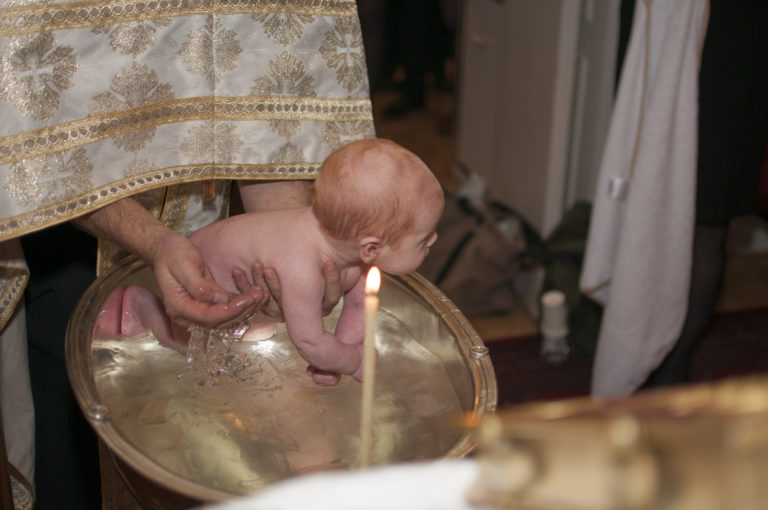
In the Orthodox Church, the baptismal service refers to a service that combines the sacraments of baptism and chrismation (anointing with myrrh, or chrism). Chrismation can be performed separately in cases where a person who has been baptized elsewhere wants to join the Orthodox Church at a later age.
Services related to the birth of a child include prayers for mothers in childbirth, naming prayers on the eighth day after birth, and churching on the fortieth day after birth.
These days, churching is usually performed only after baptism, so that the new member of the Church can partake in the Holy Communion as soon as possible after the baptism.
According to Finnish legislation, a child must be registered within two months of their birth, which is why the child is usually baptized at about two months old. At least one godparent who is a member of the Orthodox Church must be present at the baptism. Other possible godparents may be members of some other Christian Church. The priest can also help you in finding a suitable godparent if necessary. It is advisable to contact the priest shortly after the birth of the child.
On-duty priest’s contact details
About the Baptismal Service
Before baptism, the child must be given a name. The child is undressed, and the godparent brings the child – wrapped in a towel – to the priest performing the baptism. After the naming prayer, the Orthodox godparent reads the Confession of Faith on behalf of the child to assert their faith.
The actual baptismal service begins with the sanctification blessing of the water. The child is baptized by immersing them him in the water three times in the name of the Father, Son and Holy Spirit. Immersing the child in water and them then emerging from it symbolize the child’s union with Christ in his death and resurrection.
After the baptism, the baptized is dressed in white garment, symbolizing the new life given to them. The baptism is followed by another holy mystery, the chrismation.
Chrismation
The chrismation is performed immediately after the baptism. The priest anoints the baptized person with chrism, making the sign of the Cross on their forehead, eyes, nostrils, mouth, both ears, chest, hands and feet.
The chrism is the Seal and Gift of the Holy Spirit, through which the Holy Spirit becomes a part of the recently baptized Christian’s life, just as the Holy Spirit came to the apostles on Pentacost (Acts 2: 1–11). The priest recites the Bible is recited (Romans 6:3-11 and Matthew 28:16-20), and the baptized person and their godparent walk around the baptismal font three times as a sign of eternal devotion.
The Significance of Baptism
In Finland, baptism is almost always performed on small children whose parents want to ensure eternal life for their children. Baptism is the holy mystery of becoming a member of the Church. Baptism is always accompanied by a lesson on the basic principles of Christian life. The Bible tells us how entire households, including children, were baptized in the name of Christ (Acts 16:14-15). Knowing God is not something that can be understood only with the mind, which is why baptism was defined as a sacrament also for small children already in the early days of Christianity. The parents and godparents of the baptized children committed themselves to teach the children as they grew up. Even today, the parish and the Church help and support the parents and godparents in this important educational task.
Practical Matters
Talk with the priest beforehand about the baptism.
You will need a white baptismal gown, a towel, a neck cross and an icon for the baptismal service.
According to Orthodox tradition, the child is given a name of one of the holy people revered by the Church.
At least one of the godparents must be an Orthodox Christian, and possible others also members of a Christian parish.
After the baptism, the child is a full member of the Church and entitled to the holy sacraments of the Church without separate sacramental confirmation, starting from the Holy Communion.

 Päivän sana
Päivän sana  Päivän pyhät
Päivän pyhät